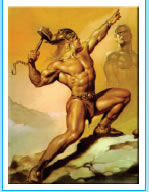INTRODUCTION TO LIGHTNING

|
Myths
THOR, the Norse god of thunder, was supposed to be a red- bearded man of tremendous strength,
his greatest attribute being his ability to forge thunderbolts. |
|
Natural Phenomena
The devastating effect of a lightning strike is amongst the most spectacular of nature's phenomena.
Gases, liquids and solids lying in the path of the huge spark are heated in a minute fraction of a second,
through tens of thousands of degrees. The voltages in lightning strikes have been measured
up to
200 kV with currents of 250KA.
The discharge of all this energy in a very small passage of time will cause damage to buildings,
towers,
structures, trees, electronics, computers, injury to people and even fatalities etc.
The economic effect is vast as it involves damage to assets and interruption to business.
|
|
History: Benjamin Franklin
Benjamin Franklin was the first researcher to study lightning and his well known kite flying in a lightning
storm was his first attempt to establish the electrical properties of lightning.
Franklin began to think about protecting people, buildings, and other structures from lightning.
This grew into his idea for the lightning rod. Franklin described an iron rod about 8 or 10 feet long
that
was sharpened to a point at the end.
He wrote:
"the electrical fire would, I think, be drawn out of a cloud silently, before it could come near enough
to strike...”
He first theorized that lightning might be preventable by using an elevated iron rod connected to
earth to empty static from a cloud.
In June of 1752, Franklin was in Philadelphia, waiting for the steeple on top of Christ Church to be
completed for his experiment (the steeple would act as the "lightning rod").
He grew impatient, and decided that a kite would be able to get close to the storm clouds just as
well.
Franklin needed to figure out what he would use to attract an electrical charge; he decided on a
metal key, and attached it to the kite. Then he tied the kite string to an insulating silk ribbon from
the knuckles of his hand. Even though this was a very dangerous experiment, some people believe
that Franklin wasn't injured because he didn't conduct his test during the worst part of the storm.
At the first sign of the key receiving an electrical charge from the air, Franklin knew that lightning
was a form of electricity. His 21-year-old son William was the only witness to the event.
Franklin began to advocate lightning rods that had sharp points. His English colleagues favoured
blunt-tipped lightning rods, reasoning that sharp ones attracted lightning and increased the risk of
strikes; they thought blunt rods were less likely to be struck.
|
|